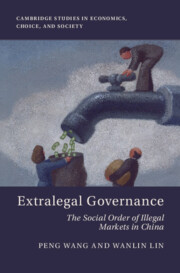
-
Select format
-
- Publisher:
- Cambridge University Press
- Publication date:
- 21 November 2025
- 25 September 2025
- ISBN:
- 9781009622158
- 9781009622141
- 9781009622172
- Dimensions:
- (229 x 152 mm)
- Weight & Pages:
- 0.446kg, 228 Pages
- Dimensions:
- (229 x 152 mm)
- Weight & Pages:
- 0.36kg, 228 Pages
You may already have access via personal or institutional login
Book description
Drawing on insights from sociology and new institutional economics, Extralegal Governance provides the first comprehensive account of China's illegal markets by applying a socio-economic approach. It considers social legitimacy and state repression in examining the nature of illegal markets. It examines how power dynamics and varying levels of punishment shape exchange relationships between buyers and sellers. It identifies context-specific risks and explains how private individuals and organizations address these risks by developing extralegal governance institutions to facilitate social cooperation across various illegal markets. Adopting a multiple-case study design to sample China's illegal markets, this book utilizes four cases - street vending, small-property-rights housing, corrupt exchanges, and online loan sharks - to examine how market participants foster cooperation and social order in illegal markets.
Contents
Metrics
Altmetric attention score
Full text views
Full text views help Loading metrics...
Loading metrics...
* Views captured on Cambridge Core between #date#. This data will be updated every 24 hours.
Usage data cannot currently be displayed.
Accessibility standard: WCAG 2.0 A
Why this information is here
This section outlines the accessibility features of this content - including support for screen readers, full keyboard navigation and high-contrast display options. This may not be relevant for you.
Accessibility Information
The PDF of this book conforms to version 2.0 of the Web Content Accessibility Guidelines (WCAG), ensuring core accessibility principles are addressed and meets the basic (A) level of WCAG compliance, addressing essential accessibility barriers.
Content Navigation
Table of contents navigation
Allows you to navigate directly to chapters, sections, or non‐text items through a linked table of contents, reducing the need for extensive scrolling.
Index navigation
Provides an interactive index, letting you go straight to where a term or subject appears in the text without manual searching.
Reading Order and Textual Equivalents
Single logical reading order
You will encounter all content (including footnotes, captions, etc.) in a clear, sequential flow, making it easier to follow with assistive tools like screen readers.
Short alternative textual descriptions
You get concise descriptions (for images, charts, or media clips), ensuring you do not miss crucial information when visual or audio elements are not accessible.
Full alternative textual descriptions
You get more than just short alt text: you have comprehensive text equivalents, transcripts, captions, or audio descriptions for substantial non‐text content, which is especially helpful for complex visuals or multimedia.
Structural and Technical Features
ARIA roles provided
You gain clarity from ARIA (Accessible Rich Internet Applications) roles and attributes, as they help assistive technologies interpret how each part of the content functions.

